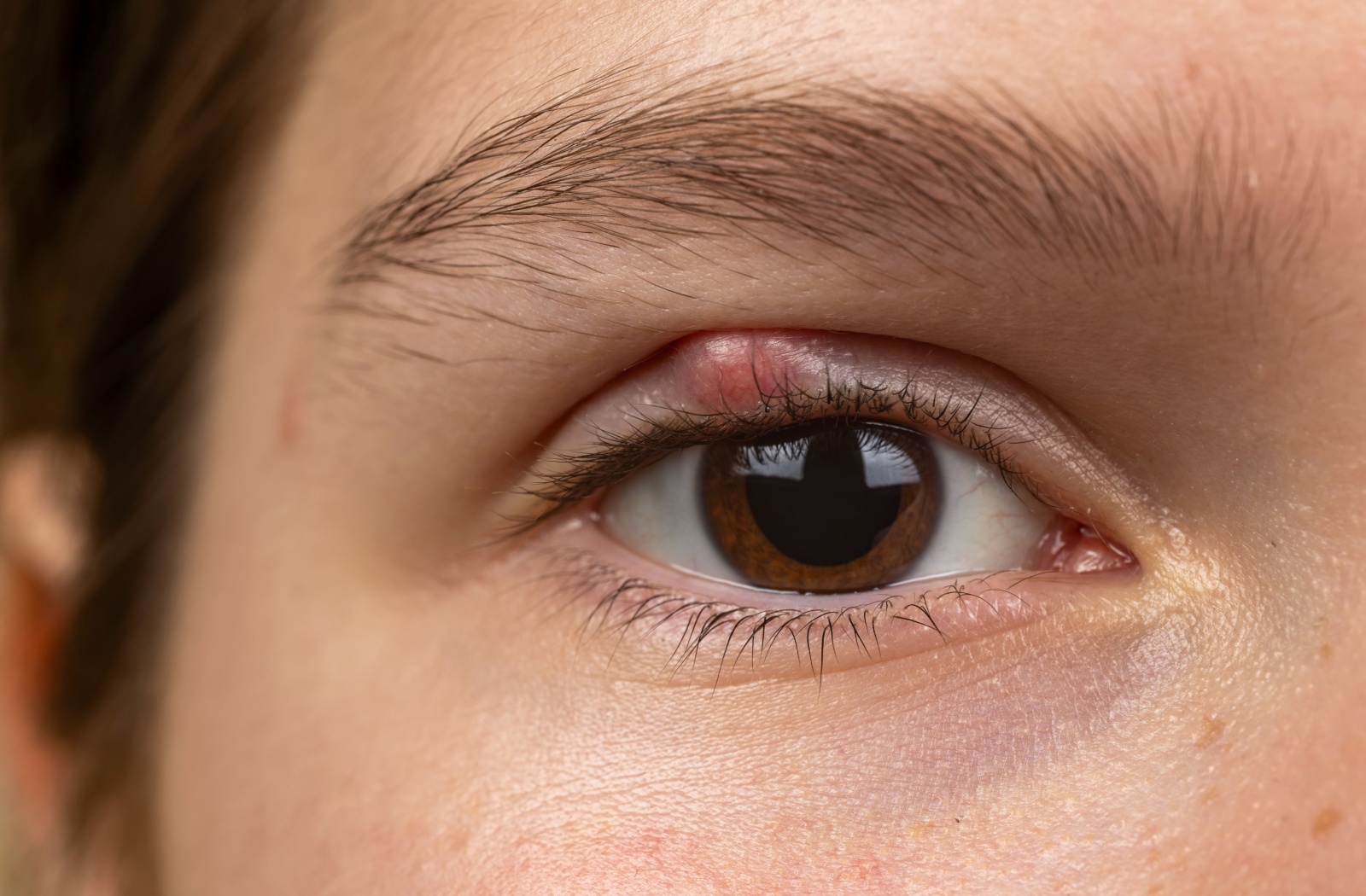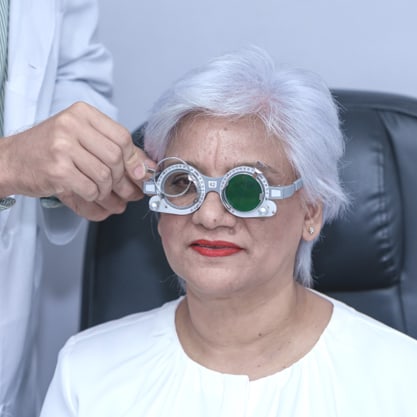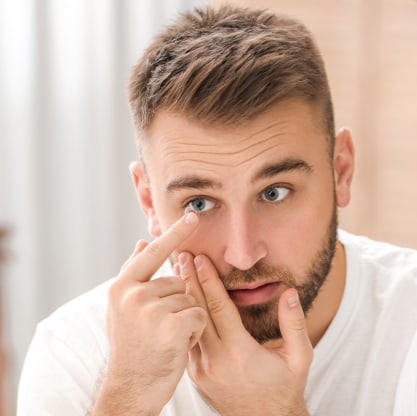Red, itchy eyes can be unsettling, especially when they resemble something contagious like pink eye. But not all eye irritation means you are spreading germs.
Blepharitis is a common eye condition that causes inflamed eyelids, but unlike pink eye, it is not contagious to others.
Blepharitis is often linked to blocked oil glands, skin conditions, or bacteria already present on the skin—not outside exposure. Knowing what causes it can help you manage flare ups and avoid unnecessary worry.
What is Blepharitis?
Blepharitis is an inflammatory condition affecting your eyelids, typically caused by clogged oil glands near your eyelash follicles. This eyelid inflammation presents in two main forms:
- Anterior blepharitis: Affects the outer edge of your eyelid where eyelashes attach. This type often stems from bacterial overgrowth or skin conditions like seborrheic dermatitis.
- Posterior blepharitis: Impacts the inner edge of your eyelid, closer to your eye surface. This form usually involves dysfunction of the meibomian glands, which produce oils that help keep your tears stable.
The condition creates a range of uncomfortable symptoms that can significantly impact your daily life. Recognizing these signs early helps ensure you receive appropriate care from your optometrist.
Recognizing Blepharitis Symptoms
Blepharitis symptoms often develop gradually and may fluctuate in severity. Common signs include:
- Red, swollen, or itchy eyelids
- Crusty buildup on eyelashes, particularly noticeable in the morning
- A gritty sensation, as if something is in your eye
- Increased light sensitivity
- Watery eyes or, conversely, dry eye symptoms
- Burning or stinging sensations around your eyelids
- Blurred vision that improves with blinking
- Foamy or frothy tears
- Difficulty wearing contact lenses comfortably
These symptoms can be easily confused with other eye conditions, which is why professional diagnosis is recommended. An optometrist can distinguish blepharitis from conditions like conjunctivitis or allergic reactions.
Preventing Flare-Ups
While you can’t always prevent blepharitis, certain habits reduce your risk:
- Practice good eyelid hygiene
- Remove eye makeup thoroughly before bed
- Replace eye makeup regularly to prevent bacterial buildup
- Manage underlying skin conditions
- Avoid touching or rubbing your eyes
- Maintain a clean environment
- Consider dietary changes that support eye health
Why Blepharitis Isn’t Contagious

Unlike some infectious eye conditions, blepharitis can’t spread from person to person through contact or airborne droplets. It comes from factors already present on your skin or within your body. Some primary causes of blepharitis include:
- Bacterial overgrowth: Normal skin bacteria, particularly Staphylococcus, can proliferate around your eyelash follicles. While this bacteria naturally exists on everyone’s skin, certain conditions can cause it to multiply excessively.
- Oil gland dysfunction: Your meibomian glands produce oils that help stabilize your tear film. When these glands become blocked or don’t function properly, inflammation can develop.
- Skin conditions: Issues like rosacea, seborrheic dermatitis, and eczema can all contribute to blepharitis by causing irritation, inflammation, and flaking around the eyelids.
- Eyelash mites: Demodex mites naturally live in hair follicles, including those of your eyelashes. Problems arise when their population grows excessively, disrupting normal oil production.
- Environmental factors: Allergies to pollen, dust, or other irritants can trigger or worsen blepharitis symptoms.
Diagnosis & Treatment Options
Treatment for blepharitis has evolved in recent years, with several options now available:
IPL (Intense Pulsed Light) Therapy
IPL therapy represents a breakthrough in blepharitis management, particularly for posterior blepharitis associated with meibomian gland dysfunction. This treatment uses controlled light pulses to:
- Reduce inflammation around the eyelids
- Improve meibomian gland function
- Decrease bacterial populations
- Stimulate healthy oil production
IPL treatment typically requires multiple sessions but can provide long-lasting relief for chronic cases.
ZEST (Zocular Eyelid System Treatment) Lid Cleansing
ZEST is a professional, in-office eyelid cleansing procedure designed to gently remove debris, oils, and bacteria that contribute to blepharitis. Using a proprietary gel formulation, ZEST effectively targets buildup along the lash line and lids, leaving the eyes feeling refreshed. This treatment can:
- Deeply cleanse the eyelid margins where bacteria and biofilm accumulate
- Reduce symptoms of irritation, redness, and crusting
- Support overall eyelid and ocular surface health
ZEST is quick, comfortable, and non-invasive, making it a valuable option for patients seeking immediate relief and ongoing management of blepharitis.
Hypochlorous Acid (HOCI) Treatment
This naturally occurring antimicrobial agent offers treatment for blepharitis. HOCl solutions help:
- Eliminate harmful bacteria without disrupting healthy skin flora
- Reduce inflammation
- Provide soothing relief from symptoms
- Support natural healing processes
HOCl is particularly beneficial for patients with sensitive skin who may not tolerate other treatments well.
Traditional Management Practices
Alongside advanced treatments, conventional approaches remain important:
- Specialized eye masks: Instead of warm compresses, specialized eye masks (available at Sage) can be heated in the microwave to provide more effective, sustained heat to the eyelids. This helps soften hardened oils and improve gland drainage.
- Gentle eyelid cleansing: Use specialized eyelid wipes or cleansers to remove debris and bacteria. At Sage, we carry tea tree oil–based lid wipes as well as individually sealed antimicrobial wipes, which are more effective and hygienic than older methods like diluted baby shampoo.
- Preservative-free artificial tears: Lubricating drops help address the dry eye symptoms that often accompany blepharitis. At Sage, we offer preservative-free options that are gentler on the eyes for long-term use.
- Prescription medications: Your optometrist may recommend topical antibiotics, anti-inflammatory drops, or oral medications for severe cases.
Finding Relief at Sage Eyecare
While blepharitis can be overwhelming, modern treatment options make this condition increasingly manageable. At Sage Eyecare, our optometrists take a comprehensive approach that addresses not just your immediate symptoms, but also the underlying causes of your eyelid inflammation.
Whether you need advanced treatment options or guidance on daily management routines, our team is here to help. Don’t let eyelid inflammation compromise your comfort and vision. Book your appointment with Sage Eyecare today and take the first step toward healthier, more comfortable eyes.

























